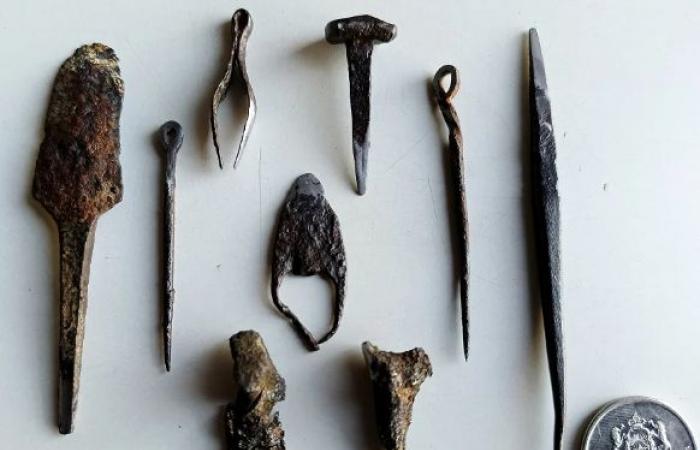The 86th meeting of the Meteoritical Society recently approved the scientific results concerning the meteoritic origin of iron artifacts discovered in the High Atlas (Morocco). This study highlights a remarkable contribution of Prof. Abderrahmane Ibhi, whose research revealed a fascinating aspect of the prehistoric era of the Imilchil region: the use of metallic meteorites in the manufacture of tools.
For millennia, humans have used a variety of materials to make tools, including metallic meteorites. These space fragments, which fell to Earth thousands, even millions of years ago, were used by our ancestors to fashion durable and efficient tools, illustrating a fascinating interaction between man and the cosmos.
Today, Moroccan specialists from the University Museum of Meteorites of Agadir, led by Professor Abderrahmane Ibhi, and their Italian counterparts from the Institute of Plasma Science and Technology have carried out in-depth research on several metallic objects unearthed in the Imilchil region (Morocco). Their analyzes demonstrated that the chemical composition of a nail and a hook strongly supported their meteoritic origin. On the other hand, dozens of other objects analyzed did not reveal the same provenance. These results constitute the second confirmed discovery of the exploitation of meteoritic iron as a source of metal in Morocco.
Since the discovery in 2022 of a meteoritic iron knife blade in the Midelt region by members of the University Museum of Meteorites and their Italian counterparts, Moroccan-Italian scientific cooperation has been initiated. This partnership, between the Moroccan National Center for Scientific and Technical Research and the Italian National Research Council, aims to intensify the search for artifacts in areas known for the fall of iron meteorites, notably in Agoudal (Imilchil, Haut Central Atlas), Oglat Sidi All in the North-West of Morocco and the Moroccan Sahara. During several expeditions, dozens of artifacts were recovered, but only two artifacts were confirmed to be of meteoritic origin after extensive analysis.
The two artifacts, a nail and a hook, were found in the Akdim region, near Imilchil. The nail, measuring 3 cm long and weighing 6 grams, and the hook, measuring 3.5 cm long and weighing 6.5 grams, have identical characteristics: very strong magnetism and severe corrosion conditions, indicating alteration prolonged probably due to the humidity of the soil and their age. The original concentrations of nickel and cobalt (approximately 5.5% Ni and 0.4% Co) strongly suggest an extraterrestrial origin, compatible with the Agoudal meteorite.
This study is the second to report the use of meteoritic iron in tool manufacturing in Morocco. However, mining metallic meteorites posed challenges. Because extraterrestrial materials were rare and difficult to find, their use was limited to certain geographic regions where meteorites were more abundant. Additionally, the process of transforming meteorites into tools required considerable technical expertise, accessible to a limited number of individuals within ancient societies.
This discovery offers a new perspective on the ancient history of Morocco and the influence of extraterrestrial materials on the development of civilization in the region. These prehistoric tools shaped by metallic meteorites represent not only a tangible testimony to our distant past, but also a mystical link with the mysteries of the universe.
In a press statement, Abderrahmane Ibhi explained that “meteorites are classified into two categories: iron meteorites and silicate meteorites. Iron can come from two sources: terrestrial iron and meteoritic iron. Terrestrial iron, extracted from rock, requires technology unknown to prehistoric humans, which means that prehistoric iron tools are probably of meteoritic origin. »
He also highlighted the importance of this discovery in archaeological research. *This discovery could open the way to a new aspect in our understanding of ancient history and demonstrates that the prehistoric man who populated these regions was Intelligent and capable of creating tools from these meteorites. »
Ibhi added that “laboratory analyzes confirm this origin, because meteoritic iron contains a large quantity of nickel (more than 5%). Analyzes were carried out on the minerals which constitute the iron tools and concluded that they are of meteoritic origin. This discovery is very important, because the field of scientific research on meteorites remains poorly understood. Morocco is the world’s leading exporter of meteorites and more than 50% of scientific articles on meteorites are made on meteorites discovered in Morocco. »
And added that “these objects are very rare, only two meteoritic iron knife blades have been discovered: the one found in Morocco and the dagger of Tutankhamun in Egypt. This discipline, of which Morocco is a flagship country, has important implications in our understanding of the history of our planet and ancient populations. »
In conclusion, this discovery highlights the ingenuity of the prehistoric men of Morocco and their ability to exploit extraterrestrial materials to create tools, thus opening a new chapter in our understanding of ancient history and the Interaction between man and the cosmos.






